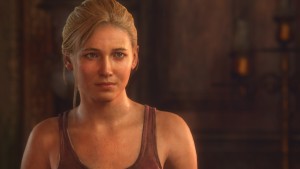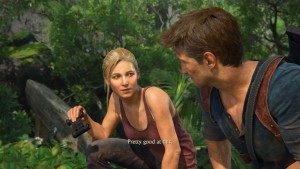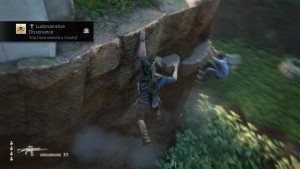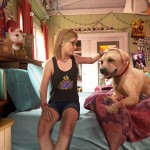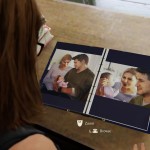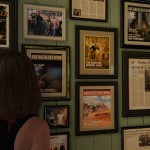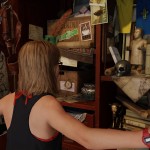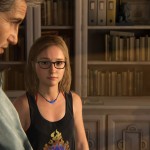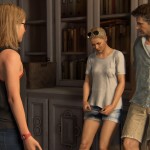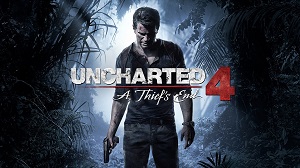 After my initial disappointment and mid-game thrills with Uncharted 4, I completed the game. Having let the experience sit for a couple of weeks and allowing the adrenaline to fade, I can say without exaggeration:
After my initial disappointment and mid-game thrills with Uncharted 4, I completed the game. Having let the experience sit for a couple of weeks and allowing the adrenaline to fade, I can say without exaggeration:
Best. Game. Ever.
I’ve never experienced a better meshing of character, story, setting and gameplay. Others have come close and even surpassed it in one or more areas. “Mass Effect” had greater depth, but the ending marred the experience. The “BioShock” games brought the drama, but lacked the longevity and depth. Lara Croft may be responsible for some great experiences, but failed to ever show any real growth as a character.
This brought everything together.
[Spoilers Ahead]
Difficulty Decisions
Based on my success with the previous games, I started the game on “Crushing” difficulty. I got hung up on chapter 13 and found many of the stealth portions challenging due to the time needed, but powered through. Then I hit the second set-piece of chapter 18.
This was an ambush set across three floors of a ruined mansion. I tried this for hours and although I did get close, I was unable to crack it. Of course I didn’t actually capture any video of that area. I tend to forget about such things after an hour of two of blinding frustration. Instead, here’s the last bit of the elevator sequence that proves Elena can take care of herself just fine.
So, after pouring 26 hours into the game on Crushing, I dropped down to normal difficulty and blasted through the last four chapters in under two hours.
It may be because I had spent so much time working with the higher difficulty, but the difference was striking. Normal difficulty, even in these more challenging endgame portions, seemed downright easy. This truly allowed the Hollywood action film flavor of the game to shine through.
Elena Makes Everything Better
As I predicted, about halfway through the game, Elena discovers Nathan’s lies. This wasn’t a surprise: Elena is the smartest character in the game by a country mile. It was a hard scene. Based on the shoddy treatment of the character in Uncharted 3, a part of me dreaded that the game would again go for dramatic reality over storybook romance.
I’m not against drama as a rule, but drama for the sake of drama is a peeve of mine.
Happily, the game bounced back in style. Being hurt terribly by Drake’s lie didn’t stop her from coming to his rescue a chapter or two later. This made me so happy. The next few chapters, featuring Elena and Nate against the odds, are my favorite of the game. There’s something insanely thrilling about seeing her leap from the bushes to snap some soldier neck.
As they adventure, Nate and Elena work through their problems. These conversations are everything that I loved in Uncharted 2 and everything that was missing in Uncharted 3.
Clichés done Right
Uncharted is often criticized for how clichéd it is. All of the gameplay, story, settings and characters are, at best, archetypical. You’ve seen similar before in everything from “Indiana Jones” and the “Mummy” movies to any number of adventure games. What Uncharted does is take those wonderful, comfortable clichés and perfect them.
More importantly, its brave enough to give the audience what they want. Often a story will fall to the idea that they must provide drama. The killing of a character or the destruction of a relationship make things real, don’t they? They show that this is something serious.
Uncharted 4 smartly says, “screw that noise”. It plays with the tropes but, in the end, gives us a hard-won, drippy sweet, Hallmark-card happy ending. Nobody dies. Drake and Elena accept that they need at least a little adventure in their lives. Sully and Sam continue on the shady side of the law, but with fewer bullets.
The End
The epilogue follows Nate and Elena’s teen daughter as she wanders through their beachside home and workshop. The detail of this section is lavish and clearly a labor of love. Every corner of the home speaks to comfort, commitment and a full, rich life.
- A girl and her dog.
- The family album.
- Every single corner of the environment is amazingly detailed.
- Pretty as a picture… of something pretty.
- D&F have been busy!
- Cassie discovers her parents past.
As the girl looks around, she finds trinkets, albums and letters that tell us that everybody is doing fine. (She also gives the dog two biscuits, but we’ll let that slide.) When she reaches the workshop, she finds her father’s keys and opens the forbidden cabinet that contains all the widgets and geegaws from their adventures.
- Caught red-handed!
- The “should we tell her” look.
- This is going to be a looong story.
Of course they decide to fess up and Drake warms up to telling the story of the first game. The game fades to black for the last time as Elena gently lays an old photograph of her, Nate and Sully back on the shelf. It’s difficult to imagine a more fitting end.
